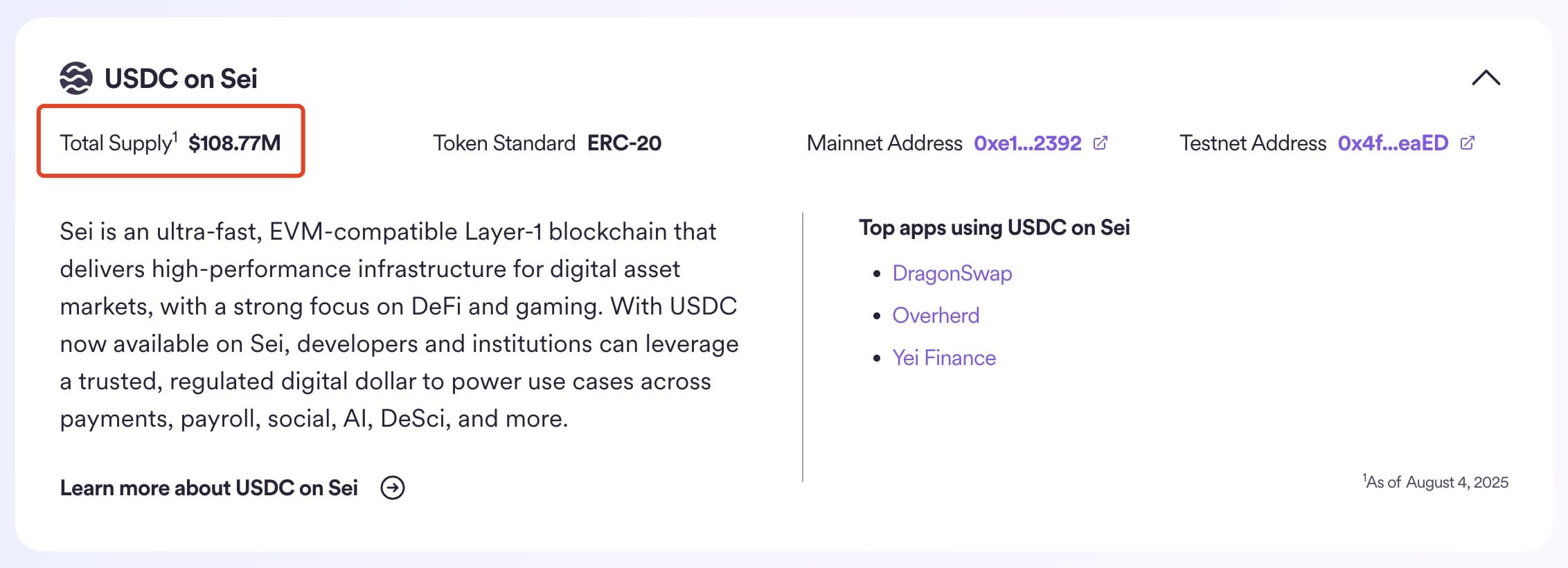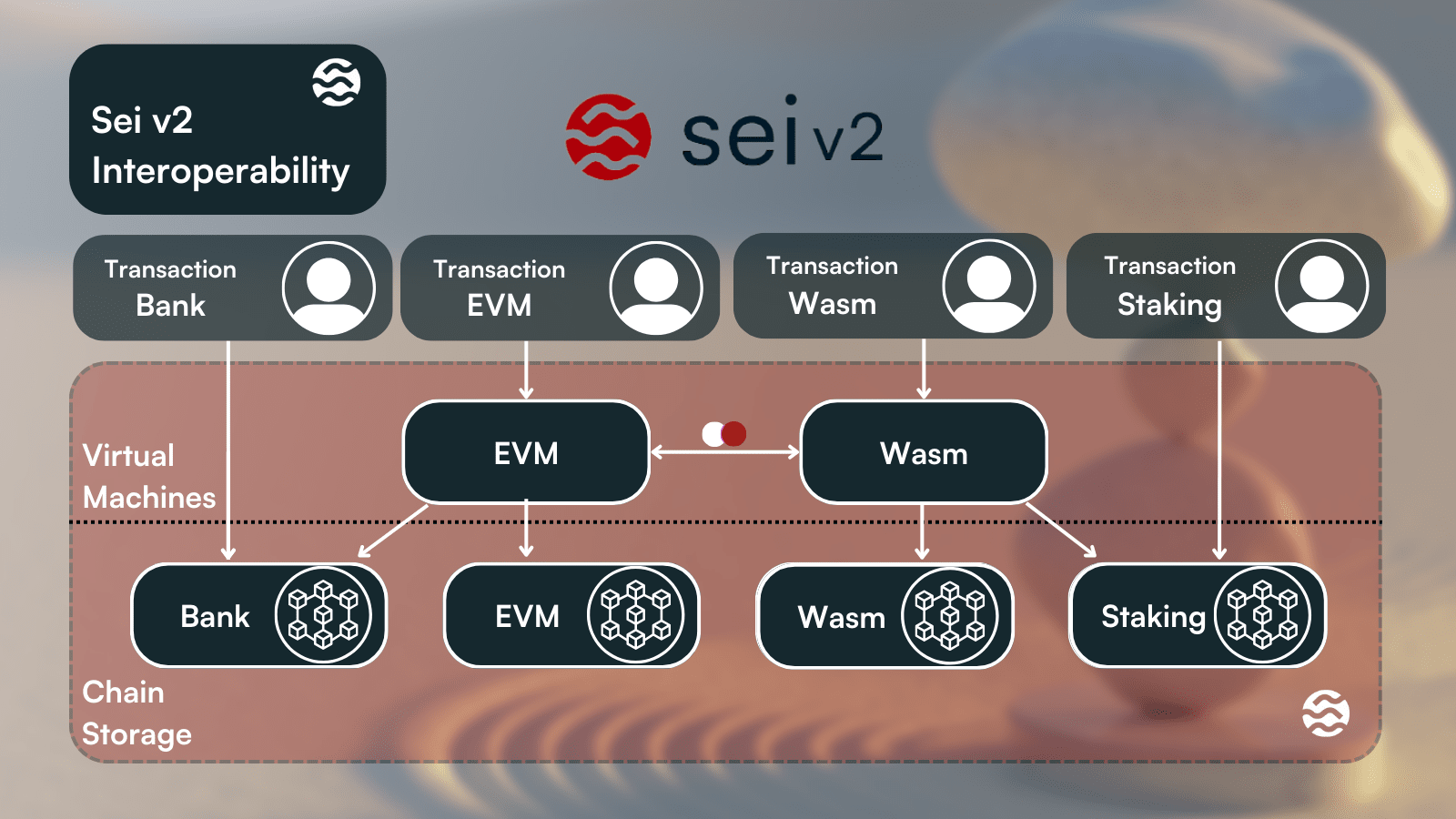Recently, a piece of news stating that 'Sei Network's daily active user count has first surpassed Solana' spread rapidly in the crypto community, accompanied by an eye-catching data comparison chart, instantly igniting market sentiment. This seems to be yet another classic narrative of the rise of a 'Solana killer'. However, when we peel back the instantaneous fog of data, we find a story that is more complex and worthy of exploration than a mere 'transfer of power'.
 Image source: (MarsBit)
Image source: (MarsBit)
The core of the story is not a brief data reversal, but about how an emerging Layer 1 public chain has achieved remarkable ecological expansion in just a few months through a clever combination of strategies. The rise of Sei is not a simple user competition, but a precise demonstration of infrastructure, capital flow, and technical narrative.
Cornerstone of growth: The 'gravitational field' of native $USDC
The first and most solid engine of Sei's recent growth comes from the native $USDC officially issued by Circle.
In the early development of public chains, stablecoins are a key indicator of their ecological attractiveness. However, not all $USDC are created equal. For a long time, many public chains have relied on 'bridged' $USDC, which are essentially wrapped vouchers of the original asset, whose security and stability are subject to the risks of cross-chain bridges. Sei chose a more difficult but correct path — collaborating directly with Circle to introduce officially issued native $USDC.
 Image source: (MarsBit)
Image source: (MarsBit)
This means that every $USDC on Sei is directly backed by Circle and can be redeemed for USD at a ratio of 1:1, with a credibility and compliance that is far superior to bridged assets. As Circle emphasizes in its official blog, the integration of native $USDC enables 'developers and users to benefit from a fully collateralized and regulated stablecoin', and opens up compliant inflow and outflow channels for institutions through Circle Mint services.
The market's reaction has been immediate. Data does not lie: within just 10 days after the launch of native $USDC, its issuance on Sei surpassed $108 million. As of early August, the total market value of stablecoins on the Sei chain has climbed to $216 million, with native $USDC accounting for 81% of the share, with a total supply close to $175 million.
What does this speed mean? We can make a lateral comparison. According to data from the on-chain data platform DefiLlama, the total market value of $USDC in the Polkadot ecosystem, which has developed for many years, is about $52 million. Sei achieved a scale several times that of a veteran public chain in less than half a month. Of course, we must also maintain a clear awareness that compared to Layer-2 giants, Sei still has a long way to go — the market value of $USDC on Arbitrum is as high as $2.44 billion. But this astonishing initial growth rate is enough to demonstrate that native $USDC has built a strong capital 'gravitational field' for Sei, attracting the first wave of core users and funds seeking a stable and efficient DeFi environment.
Ecological explosion: From capital entry to scenario landing
With a solid capital foundation, the next step is to make this capital 'live'. Sei provides direct landing scenarios for the influx of native $USDC by introducing key applications.
Among them, the lending protocol Yei Finance plays a key role. Yei Finance is not a brand new species created out of thin air, but a fork of the well-tested Aave V3 protocol in the DeFi world. This strategy appears very pragmatic: it offers users a familiar, reliable platform with rigorously audited code to park and utilize their $USDC assets. For early users, security and familiarity are far more attractive than untested 'innovation'. At the same time, native lending protocols like Takara Lend are also rapidly emerging, forming a dual engine for lending in the Sei ecosystem alongside Yei Finance.
If DeFi protocols are the 'reservoir' for capital, then the integration with Backpack is a key step in opening the 'tap'. Backpack is a widely popular multi-chain wallet and exchange in the Solana ecosystem. Its comprehensive integration with Sei provides a nearly frictionless entry point for the vast Solana user base, allowing them to easily transfer their assets and attention to Sei. This is not only a technical integration but also a precise user 'migration' guide that explains part of the source of Sei's recent surge in activity.
However, on-chain activity does not all come from organic DeFi activities. An anonymous social application called Overherd reveals another side of Sei's growth. As a SocialFi platform in a closed testing phase, Overherd has designed a clear point and reward system, allowing users to earn expectations for future token airdrops by posting content and interacting. This incentive-driven model has undoubtedly contributed a significant amount of on-chain transactions to Sei, although the value and sustainability of these transactions remain to be observed. This indicates that Sei's growth is a hybrid — consisting of both genuine DeFi demand attracted by strong infrastructure and potential users drawn in by precise incentives.
Technical narrative: Parallel EVM, a different high-performance path
Behind all the noisy growth data lies Sei's core technical proposition — Parallelized EVM. This is the confidence that allows it to challenge high-performance public chains like Solana.
 Image source: (MarsBit)
Image source: (MarsBit)
For a long time, the blockchain world has faced a dilemma: to choose the breadth of the Ethereum EVM ecosystem or the performance height of non-EVM chains like Solana? Sei attempts to provide a third answer. Its core technology 'Optimistic Parallelization' differs from Solana's parallel processing mechanism.
Solana requires developers to explicitly declare the state that the transaction depends on (i.e., which accounts will be read or written) when submitting transactions, allowing the system to process non-conflicting transactions in parallel based on these dependencies. Sei goes a step further, 'optimistically' assuming that all transactions can be executed in parallel, and only rolls back and reorders conflicting transactions when a conflict is detected during execution (for example, two transactions modifying the same account simultaneously).
This design is more friendly to developers accustomed to the EVM environment, lowering the threshold for them to build high-performance applications. Sei's official documentation claims that with its 'Dual Turbo Consensus' and the database 'SeiDB' tailored for parallelization, the network can achieve sub-second transaction finality, with a theoretical TPS (transactions per second) reaching 12,500. Although in actual operation, a TPS of 2,000 to 4,000 is more common, this has firmly placed it in the first tier of high-performance public chains.
Endgame outlook: Carving out a new battlefield among giants
Looking back at that initial moment of 'daily active users surpassing Solana'. According to Nansen's broader 7-day average data, the number of weekly active addresses on Solana (about 22.24 million) still far exceeds Sei (about 4.07 million). This confirms our judgment: that surpassing was a brief 'highlight' rather than a comprehensive 'overthrow'.
However, this does not diminish the significance of Sei's rise. It showcases the competitive strategy of a new generation of public chains: no longer a single-dimensional technical competition, but a three-dimensional war of infrastructure, ecological strategy, capital operations, and technical narrative. Sei is vigorously promoting ecosystem development through an ecosystem fund of over $100 million, which contrasts sharply with Solana's bottom-up community-building model relying on hackathon culture.
In the future, with the landing of more native projects like Ondo Finance's RWA asset USDY, the ecological thickness of Sei will further increase. Its goal may never have been simply to become another 'Solana killer', but to carve out a new battlefield capable of supporting large-scale applications between Ethereum's EVM empire and Solana's high-performance island. For developers and project parties eager for extreme performance but unwilling to give up the mature toolchain of the EVM ecosystem, Sei undoubtedly offers a highly attractive option. This grand drama has only just begun.
This article is authorized to be reproduced from: (MarsBit)
Original title: (Sei's user count 'surpasses' Solana: A fleeting moment in the L1 power landscape or a fundamental change?)
Original author: Luke, Mars Finance
'Sei's daily active users have first surpassed Solana! Is this a shift in the public chain battlefield or a fleeting moment?' This article was first published in 'Crypto City'




